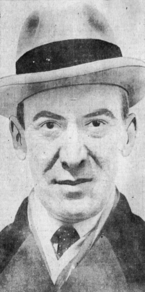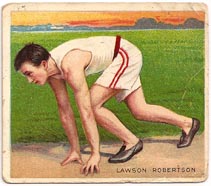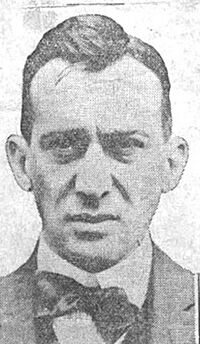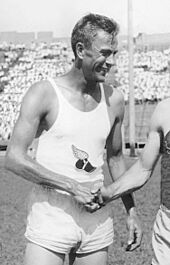Lawson Robertson facts for kids

Robertson circa 1927
|
|||||||||||||||||||||||
| Personal information | |||||||||||||||||||||||
|---|---|---|---|---|---|---|---|---|---|---|---|---|---|---|---|---|---|---|---|---|---|---|---|
| Born | September 23, 1883 Aberdeen, Scotland |
||||||||||||||||||||||
| Died | January 22, 1951 (aged 67) Philadelphia, Pennsylvania |
||||||||||||||||||||||
| Occupation | Head Track Coach Irish-Amer. Club '09-16 U of Penn '16-47 US Olympics '24-36 |
||||||||||||||||||||||
| Height | 183 cm | ||||||||||||||||||||||
| Weight | 68 kg (Olympics) | ||||||||||||||||||||||
| Spouse(s) | Mary Helen Teevan | ||||||||||||||||||||||
|
Medal record
|
|||||||||||||||||||||||
Lawson "Robbie" N. Robertson (born September 23, 1883 – died January 22, 1951) was a very successful American track coach. He was known as one of the best coaches in the first half of the 1900s.
Robertson was part of the American Olympic team from 1904 to 1936. The only time he missed was in 1916, when the Olympics were canceled due to World War I. He coached track and field for the Irish-American Athletic Club from 1909 to 1916. After that, he coached at the University of Pennsylvania from 1916 to 1947. He was an assistant coach for the U.S. Olympic team in 1912 and 1920. Later, he became the head coach for the American Track and Field Team in four Olympics, from 1924 to 1936.
Before coaching, Robertson was an Olympic athlete himself. He competed in track and field in the 1904 and 1908 Olympics. At age 21, he won a bronze medal in the Standing high jump at the 1904 Summer Olympics in St. Louis. Two years later, he won a silver and a bronze medal at the 1906 Intercalated Games in Athens. He also competed in the 1908 Summer Olympics in London but did not win a medal there.
Contents
Early Life and Athletic Start
Lawson Robertson was born in Alford, Scotland, on September 23, 1883. He moved to New York around 1892 when he was about nine years old. He went to Boys High School in Brooklyn. Interestingly, he didn't play sports in high school.
Robertson started competing in track events around 1901, after he finished school. He began his athletic journey in New York City. He won many championships for the YMCA and later for the New York Athletic Club. Lawson was a very skilled track athlete. He was good at short races (dashes), pole vault, high jump, shot put, and middle-distance races.
In 1901, Robertson won the all-around championship for the Brooklyn YMCA. He won the national 100-yard title in 1904. He also won the 300-yard national title in 1906 and 1908. In 1907, he won both the 150-yard and 300-yard titles. In 1909, he set a record of 11 seconds for the 100-yard three-legged race. He did this with his friend and fellow Olympian, Harry Hillman.
Olympic Competitions
1904 Olympics in St. Louis
In August 1904, Lawson Robertson won his only Olympic medal. It was a bronze medal in the Standing high jump competition. He jumped 1.44 meters (about 4.7 feet). In the 100 meters event, he finished sixth. He also took part in the 60 meters competition. However, he was eliminated in the first round.
1906 Intercalated Games in Athens
Two years later, in 1906, Robertson competed in the Intercalated Games in Athens. He won a silver medal in the standing high jump. He also won a bronze medal in the standing long jump. For many years, people thought these were like regular Olympic Games. However, the Olympic committee later decided they were not official Olympic Games.
In the 100 meters event, he finished fifth. In the pentathlon contest, he finished sixth. He also entered the 400 meters competition but did not start the final race.
1908 Olympics in London
A trading card from 1910 described Lawson as "one of the greatest sprinters." In the 100 meters competition at the 1908 Olympics, Robertson won his first race. His time was 11.4 seconds, which moved him to the semifinals. In the semifinals, he had a very close race with another American, Nathaniel Cartmell. Both ran in 11.2 seconds, but Cartmell won by a small distance. This loss meant Robertson did not go to the final.
On the same day, Robertson also competed in the 200 meters. He finished second in his heat with a time of 23.0 seconds. This was not fast enough to move on. He also participated in the standing high jump competition again, but his exact result is not known.
Accident and Recovery
On November 28, 1909, Lawson Robertson was involved in an accident. He was badly burned at Celtic Park in Queens, New York. He was preparing to pour hot lead for a 42-pound shot put. Some water dropped into the hot lead, causing a small explosion. This burned Robertson's face and neck. Luckily, his eyes were closed tightly, so they were not hurt. After the accident, he was quickly taken to a doctor. Even after this, the competition continued. Another athlete, Martin Sheridan, set a new world record with the same shot put.
Coaching Career
After his time as a top athlete, Robertson coached at the New York Athletic Club in 1909. He also coached at Brooklyn College and New York University.
Robertson became very well-known as a coach for the successful Irish-American Athletic Club in Queens, New York, starting in 1909. This club had amazing athletes who held many records. While he was a good athlete, Robertson is best remembered as an outstanding coach. Many consider him one of the most accomplished American track coaches of his time.
Robertson was also special because he brought the javelin throw to U.S. track and field. He introduced it after the Athens Olympics in 1906. During World War I, he briefly served as a Lieutenant in the Air Service.
Coaching at the University of Pennsylvania
Robertson coached the Irish-American club until February 1916. Then, he accepted a coaching job at the University of Pennsylvania in Philadelphia. He coached at Penn for 31 years, until July 1947, which was a major part of his career. His Penn teams won important championships. For example, his teams won the Indoor Intercollegiates in 1923, 1924, 1930, and 1931. His 1920 team won the Outdoor Intercollegiates.
Robertson was also skilled at teaching conditioning. He even coached conditioning for the University of Pennsylvania Football Team. He learned a lot about tough training from his nine years in the National Guard in New York.
Famous Penn Athletes He Coached
Lawson Robertson coached many exceptional athletes at Penn. These included:
- Ted Meredith: A 1912 Olympic Gold Medalist runner.
- Bill Carr: A 1932 Olympic Gold medalist in the 400-meter run and relay.
- Gene Venzke: A sprinter who set a World Record in the 1500 meters in 1936.
He also coached other record holders like Matt McGrath, Dan Ahern, and Emilio Lunghi. Robertson coached nearly a dozen record holders and amazing track athletes at Penn. He once said, "speed is born in a runner and endurance can be developed." He always emphasized eating well and getting enough rest. Robertson was known for helping his athletes reach their full potential and for his forward thinking.
U.S. Olympic Track Coach
In 1912, the U.S. Olympic track & field team coach, Mike Murphy, became ill. Robertson, as the assistant coach, stepped in to lead the team. The team won 16 out of 32 possible gold medals in track and field that year. He also served as an assistant Olympic Track and Field coach in 1920.
Head Olympic Track and Field Coach
As a highlight of his coaching career, Robertson became the head coach for the American Track and Field Team in four Olympics. These were from 1924 to 1936. In 1928, at the Olympic Games in Amsterdam, Robertson spoke about the controversial 1908 Olympics. He said that England might not have been very welcoming to the American champions. He also noted that the winning Americans might not have been as humble as they should have been.
Robertson was involved in a controversy at the 1936 Berlin Olympics. This was his last year as head coach. He made a last-minute decision to remove Sam Stoller and Marty Glickman from a relay race. They were the only two Jewish athletes on the U.S. track team. This led to a lot of talk that the U.S. Olympic Committee chairman, Avery Brundage, ordered this. People thought it was to avoid upsetting Adolf Hitler if two American Jewish athletes won gold medals. It's important to know that Robertson did not support Hitler's government after returning to America. He warned Americans that Germany's growing military could be a threat.
Robertson coached both Black and Jewish Olympians. This included the amazing Black Olympian Jessie Owens in 1936. He also coached Jewish Olympian Louis Clarke, who won a gold medal in the 400-meter relay in the 1924 Paris Olympics.
Retirement, Death, and Honors
Lawson Robertson retired from coaching in July 1947 because his health was declining. He passed away in Philadelphia on January 22, 1951, after being ill for two months. He was buried in West Laurel Hill Cemetery in Bala Cynwyd, Pennsylvania. He was survived by his wife, Mary Helen, his children George, Lawson Jr., and Dorothy, and three sisters. Another son, Charles Alexander, died in World War II in 1944. He was a Navy dive-bomber pilot whose plane was shot down.
A plaque honoring Lawson "Robbie" Robertson was placed at Franklin Field at the University of Pennsylvania in 1953. He is also a member of the University of Pennsylvania Athletics Hall of Fame. He was one of the few coaches chosen for the Helms Hall of Fame in Los Angeles.
Portrayals in Film
- Lawson Robertson is played by Tony Curran in the 2016 sports movie Race.





